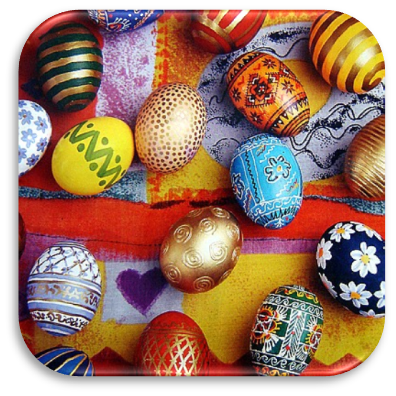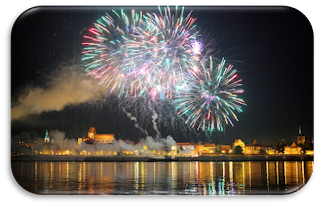Polish traditions and culture
Polish traditions and culture
Heloooo my dearest readers. It is time for another blog post 😊
As I’m writing this post it is actually first day of astronomical Spring (20st
of March). This just reminded
me that when I was in primary school, we used to drown
the Marzanna, and thinking about this ritual
now gives me the impression that we (Polish people) are a little insane lol.
 |
| Drowning the Marzanna |
 |
| Drowning the Marzanna |
So, I've decided that this post will be about strange for not Polish people Polish traditions 😆
 |
| Polish doughnuts |
Fat Thursday (Tłusty Czwartek)
Pancake Day in Poland is more like Doughnut Day however as I'm living in Scotland of course I'm celebrating both of those yummy traditions 😄 Foods like fat and sugar are commonly given up during Lent in Poland, therefore many ingredients need to be used up before the fasting weeks begin. Sweet fried Faworki (angel wings) pastries and Paczki (pownch-key) doughnuts filled with fruit jam (rose-flavored is a favourite) or cream are top sellers. Fat Thursday, five days before Shrove Tuesday, is a full-on national celebration with doughnuts given in offices and queues outside bakeries. I remember that me and my dad used to have an competition who will eat more, I think I've managed 10 in setting my record 😂
 |
| Three Kings |
Three Kings Day (Trzech
Króli)
On Twelfth Night after Christmas in Poland, there are parades,
nativity plays, carols, candies, and cakes. The day the three kings arrived at
the stable, 6 January, has been a national holiday since 2011. Some families
carry gold, incense, and amber (to represent the kings' presents) to be blessed
at mass, then put the initials of Kaspar, Melchior, and Balthasar over the
entrance to bring good luck all year. The king of the day is whoever finds the
lucky coin or nut baked inside the king cake.
 |
| Christmas Eve supper |
Twelve
Dishes on Christmas Eve (Wigilia)
Unlike other countries, Poland celebrates Christmas Eve, or Wigilia, the night before. Wigilia is a long-lasting feast that begins when the first star appears. A vegetarian Wigilia meal contains 12 courses, one for each month of the year. Honey, almonds, beans, barley, beets, fruit, mushrooms, and fish (fried herring or carp, or even stuffed pike perch). Borscht, various soups, pierogi (dumpling pies), dishes with poppy seeds, and pastries abound. I absolutely love the Wigilia, we are still trying to celebrate it in Scotland with my Polish friends. The food never ends and even if you absolutely stuffed you are still eating 😋
On Easter Monday in Poland, expect to get sprayed
with water on the street. Smigus-dyngus (also known as Wet Monday) originated
as a medieval seduction practise where boys splashed young women. It's a
public holiday in Poland today, so everyone can participate, and sophisticated
equipment like water pistols and garden hoses are encouraged. Don't carry items
that will be damaged by water, including cameras, laptops, or passports,
because you may be ambushed at any time.
 |
| Poprawiny |
Do you have a vodka head? You'll need one for the Polish ceremony of Poprawiny. In Poland, a wedding is traditionally two days long, including a post-wedding party that lasts into the early hours. The after-party is less formal and lasts until early evening. Modern brides and grooms may not follow the tradition, but if you attend a rural wedding, you can expect Poprawiny will be there. Remember the paracetamol and plenty of water for dehydration.
 |
| All Saint's Day |
Uroczystosc Wszystkich (All Saints Day) is a
stunning event in Poland, with oceans of tea lights and crowds. On November 1,
millions of Poles gather at local graveyards to pay respect to their departed
loved ones by placing flowers and candles on their graves. The most attractive
cemeteries to visit in Poland are Powiazki in Warsaw and Rakowicki and Salwator
in Krakow. The celebration is also known as Dzien Zmarych , which means
Day of the Dead in Polish.
 |
| Andrzejki |
Poles also celebrate St Andrew's Day differently (30
November, although the festivities can kick off on the evening of 29 November).
The festivities include fortune-telling activities like pouring candle wax into
cold water through a keyhole to produce a wax figurine whose shape is used to
predict the future. The humorous shoe race custom is key to the celebration, as
everyone in the room removes their shoes and lays them across the floor, one
pair after another, starting at the wall furthest from the door. The owner's
first pair of shoes indicates wedding bells.
 |
| Name day wishes |
In Poland, everyone has a name day in addition to a birthday, and many individuals (especially older people) prefer to celebrate this before their birthday so that they do not have to publicly reveal their age. This Catholic custom is tied to the naming of children after saints. We will do everything for presents and any occasion to raise a glass.
Lector (voice dubbing) of films presented on TV is one of the most irritating traditions for foreigners in Poland, trust me my boyfriend absolutely hates it however I`m used to it and it is not bothering me at all. A lector reads the translation over the original voices in the majority of English language films. The craziest thing about this is that the lector is just one guy who talks in a flat, monotone deep voice over the sounds of men and women 🙈
 |
| Sylwester in Poland |
The celebration of New Year's Eve in Poland is similar to that of other areas of Europe. Individuals organise parties, attend private gatherings, and congregate in city squares for spectacular fireworks displays.... All of the parties last to the early morning so be prepared for the long night full of food, dancing and vodka! In Poland, the first of January is a popular day for concerts in auditoriums and carol services in churches throughout the country. For example, if you travel to Krakow, Poland, in January, you will be able to attend the Philharmonic's year-opening concert.
 |
St Nicholas Day |
On the morning of St. Nicholas Day (called Mikolajki), children can expect small gifts and sweets; in fact, St. Nicholas Day was once the only day in December when gifts were distributed. Western traditions influenced the habit of giving out gifts on Christmas Eve or Day. So, larger gifts are now held for Christmas, and smaller mementos and sweets are discovered on December 6th—under pillows, inside shoes and boots, and stockings hanging the night before. I remember well the anticipation in the morning before I checked my polish shoes for any goodies in them, absolutely priceless. I'm continuing this tradition with my daughter Kaja 😊
 |
| Decorated eggs for Easter |
Easter celebrations in Poland are both significant
and symbolic. The Easter season is marked by blessed food and adorned eggs,
church services, Easter palms, and seasonal markets that assist to commemorate
this springtime celebration of faith and joy, as well as cherished traditions,
food, and family.
 |
| Polish raw mince and egg-Tatar |
 |
| Chicken soup - Rosol |
 |
| Polish Dumplings - Pierogi |
I've run out of word count for this post so I can't present to you the Polish cuisine in the way I would like to but this is a short video about the most popular dishes and this is a great website about the traditional Polish food too. Please have a look!
Thanks for reading, I hope that you
enjoyed browsing through this post, if you didn’t ready my previous posts, you
can find them in here:
Post 1 - an Introduction to beautiful Poland
Post 2 - my amazing hometown Torun
Post 3 - the lovely Polish coastal destinations





We are not crazy at all 🤣🤣🤣
ReplyDeleteWell.. it depends how you will look at it 😆
DeleteLoved this blog Daria and love learning about all the Polish traditions....particularly Fat Thursday!
ReplyDelete